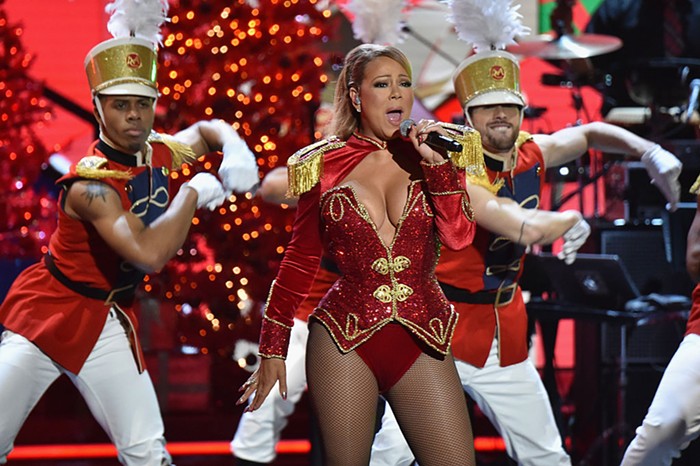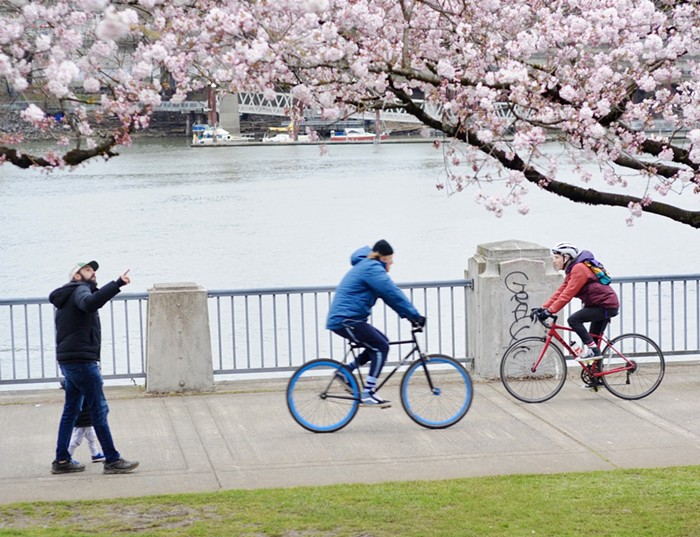ON VALENTINE'S DAY morning, when I noticed the daffodils in my garden were blooming robustly, I panicked.
I'm used to seeing a few early daffodils or crocuses in February, but I write them off as obnoxious, relentlessly chipper overachievers—the botanical equivalent of Ned Flanders. I wasn't expecting full beds of bright, healthy flowers. Plants like daffodils need warm soil and plenty of sunshine to bloom, and the record number of t-shirt-weather days in February and March didn't assuage my sense that something was way, way off here—even as friends on the East Coast posted photos of terrifyingly high snow drifts.
West Coast governments seem to share my concern, as governors of both Oregon and Washington have declared emergency drought conditions in both states, and California has entered its fifth year of major drought—the worst in 1,200 years. Not to mention that the Cascades snowpack is at 8 percent of normal in some places. Eight percent!
Yes, it sounds alarming—but what does is mean for people living in typically soggy Portland, where most of us assume there will always be plenty of water? Those of us who live on the "wet side" of the state often take it for granted that it will always be, well, wet here.
That's not necessarily true. Climatologists think even the milder sections of the Pacific Northwest are probably going to get hotter and drier as the planet heats up. According to an Oregon Climate and Human Health profile report released in 2014, hot, dry summers—and droughts—will probably be the new normal in Western Oregon. But just how soon will that new norm kick in?
Rain, Rain... Come and Stay
At the end of January, meteorologists were sounding a dire note about not only seeing warmer temperatures, but also months that were much drier than normal. However, toward the end of March it started to pour—we received 4.71 inches of rain, more than double the normal amount—and things felt right again, if still weirdly warm.
Jaymee Cuti, the spokesperson for the Portland Water Bureau, explained that other watersheds throughout the state—those in colder, higher-elevation regions—depend on snowpack to maintain normal water levels, but this isn't the case for the Bull Run Watershed, from which Portland gets its drinking water.
Since the Bull Run Watershed doesn't depend on snowpack, spring rains make a big difference, Cuti explained. "Low snowpack levels are not expected to affect Bull Run's water supply as much as they'll affect snow-dominant watersheds in the Pacific Northwest," Cuti said. "If late spring precipitation totals end up being in the typical range, the city would anticipate a relatively normal summer water supply situation."
The National Weather Service's three-month outlook for May, June, and July (released last week) predicted equal chances for either above- or below-normal spring precipitation levels on the West Coast.
Cuti also noted that Portland Water's customers have become much more efficient in their water use over the last 15 years; the water bureau has seen a 31 percent decrease in residential per capita water use within the city since 1999, offsetting a 27 percent increase in the population of the Portland service area. Total demand of water from the bureau declined by 11 percent in the same time frame, and average daily consumption during the summer months declined by 18 percent. Cuti attributed the efficiency increases in part to "passive changes" like more efficient plumbing structures (today's toilets use way less water per flush than toilets in the '90s), as well as denser planning and smarter landscaping.
Heating Up?
Regardless of how much water is available, we can almost certainly expect a hotter summer, according to Andy Bryant, a hydrologist for the National Weather Service.
"The forecasts are strongly indicating above-normal temperatures all the way through the summer months, continuing what we've seen since early January," Bryant said.
Rising temperatures—and low river levels (with warmer water temperatures)—mean farmers and other businesses in Eastern Oregon are already planning for a dry summer. That could mean higher food prices—though the US Department of Agriculture's projections, released in February, noted prices didn't increase as much in 2014 as previously predicted. And, this year the agency expects relatively modest increases—2 to 3 percent—in the price of groceries.
Bryant also noted river temperatures are higher than average, which, along with low river levels, will affect freshwater fish populations. And government officials in rural Oregon counties are expecting businesses that rely on outdoor recreation—including guide and gear rental services, as well as grocery stores—will take a revenue hit as river levels continue to drop.
Meanwhile rural communities in the Willamette Valley are facing a tough summer for the same reason: Reservoirs in the Willamette Valley Project are at 40 percent of their normal fill schedule. Scott Clemans, a public affairs specialist for the US Army Corps of Engineers Portland district, said drinking water supplies in those areas won't be affected. But low reservoir levels mean many sites won't be usable for boating or swimming, and higher temperatures mean fewer fish.
Closer to home, Alice Busch, Multnomah County's emergency management training and exercise coordinator, said the county is beginning to plan for the likelihood of hotter summers in the Portland area—but officials don't yet have all the data they need to successfully strategize. When emergency services respond to calls for first aid, they don't keep records tracking the specific nature of the call, or if it's connected to an adverse weather event. So there's no way to figure out if there's a corresponding uptick in the number of people who need medical assistance due to heat exhaustion. Busch said the county is working with emergency medical services, and trying to get data from other larger cities, to see if they can streamline coding to better predict the health effects of a hotter future.
The Next Big Wave
For the moment, Portland is likely to weather this, and probably the next few summers, reasonably well—and our part of the Northwest is expected to see the least disruption due to climate change. That isn't to say we won't be unscathed: Before we end up underwater (due to the fact that much of Portland is at a relatively low sea level), ocean acidification will probably damage the already-hurting fishing industries on the coast and impact tourism as well.
When my friends speculate about various apocalyptic scenarios, one of the inevitable questions is what "we" will do about all the people moving here from areas that have been devastated by global warming. This "inevitability" strikes me as perhaps a bit smug, but there is some truth to it; people are already moving to Portland in droves—note the aforementioned 27 percent increase in Portland Water customers. And historically, climate change can and does drive migration patterns—both animal and human. A 2014 analysis by the International Food Policy Research Institute looked at migration patterns in Pakistan and found that hot temperatures (more than sudden natural disasters like floods) were the major driver of migration waves from country to city, probably due to farming failures when land became unproductive. So maybe it's not that far-fetched to assume the Willamette Valley will see a large influx of people coming from regions more adversely affected by changes in climate.
In 2008, Metro predicted the Portland metro area's population could double to 3.9 million by 2060 due in part to an influx of "climate refugees"—people displaced by drought, flood, or other extreme weather changes. That's even as Oregon itself is likely to experience economic flux and food insecurity due to increased heat.
Metro, the Portland Water Bureau, and other agencies are in the early stages of discussing how to prepare for a possible massive wave of transplants. For now, Busch and Multnomah County Aging and Disability Services Program Manager Paul Iarrobino advise people to remember seemingly basic self-care, like staying hydrated and out of direct sunlight when temperatures climb, as well as reminding neighbors to check in on each other.
"One of our main messages is the importance of people looking out for each other when it's getting hot," they said. "We tell people to check on their older neighbors and, if they can, invite them to a movie or some other air-conditioned space. The important thing is for neighbors to look out for each other."













